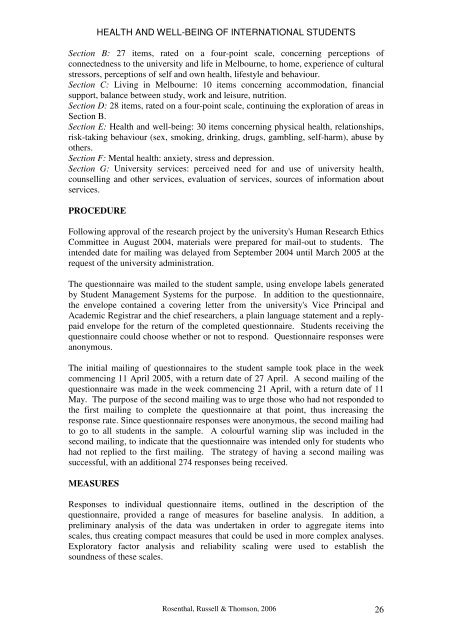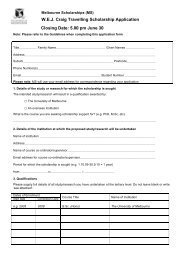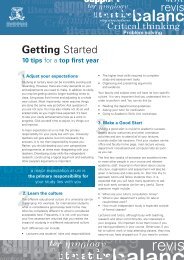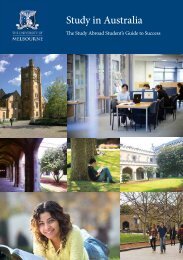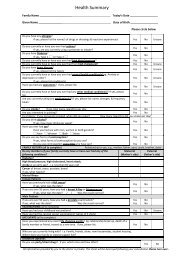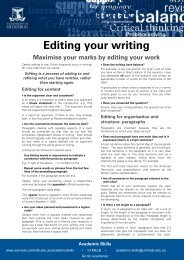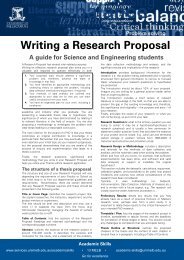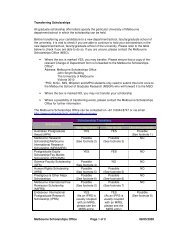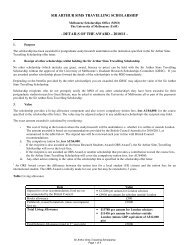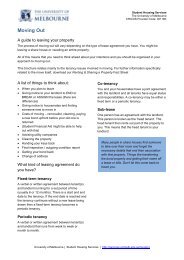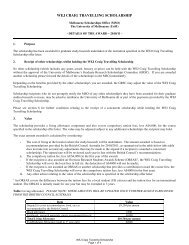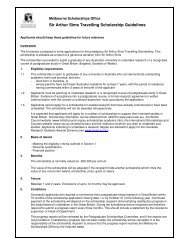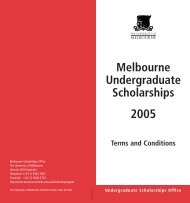HEALTH AND WELL-BEING OF INTERNATIONAL STUDENTSThe sample does vary from the population on the variable <strong>of</strong> gender. A higherpercentage <strong>of</strong> female students responded to the questionnaire, proportional to theirrepresentation in the university population. This is not unexpected. Females tend tobe more compliant than males in their responsiveness to survey requests. A recentexample is to be found in the study <strong>of</strong> the <strong>experience</strong> <strong>of</strong> first year students inAustralian universities (Krause et al., 2005), where 66 and 34 per cent <strong>of</strong> females andmales responded to the survey, compared with their respective representation (57 and43 per cent) in the commencing undergraduate population. These figures are verysimilar to the gender representation in the current sample and population. Care willbe taken in reporting results to consider possible gender differences.Because this study was designed as an exploratory study to obtain baseline data aboutthe health and well-being <strong>of</strong> international students at The <strong>University</strong> <strong>of</strong> <strong>Melbourne</strong>,comparative data on domestic students were not collected. Had domestic studentsbeen included, the questionnaire content would have had to differ. It is anticipatedthat a comparative study will be undertaken in the future, based on the knowledgegained from the present study. It is thought preferable that such a study be undertakenin semester 2, rather than semester 1, when first-year students have had a little moretime to gain <strong>experience</strong> in their role as international students living and studying in<strong>Melbourne</strong>.INSTRUMENTThe research instrument used in the study was a questionnaire developed specificallyfor the purposes <strong>of</strong> the project. Areas to be included in the questionnaire wereselected on the basis <strong>of</strong> the information needed to address the research questions.Relevant sections <strong>of</strong> the research literature, including health-related questionnairesused in other settings, were consulted in the process <strong>of</strong> the questionnaire construction(Church, 1982; Hakim, 2004; McInnes, Griffin, James & Coates, 2001; Patton, Bond,Butler & Glover, 2003; Reininger, Evans, Griffin, Valois, Vincent, Parra-Medina,Taylor & Zullig, 2003; Rosenberg, Schooler, Schoenbach & Rosenberg, 1995; Sanhu& Asrabadi, 1994; Smith, Agius, Dyson, Mitchell & Pitts, 2003; Women’s HealthAustralia, 2002). It was estimated the questionnaire would take a maximum <strong>of</strong> 30minutes to complete. A copy <strong>of</strong> the questionnaire is contained in Attachment 2.The draft questionnaire was presented for discussion to a meeting <strong>of</strong> the AdvisoryGroup 9 that had been established to assist in the development <strong>of</strong> the project and in theconsideration <strong>of</strong> findings and recommendations. Suggestions from Advisory Groupmembers were used to refine the questionnaire. A few additional modifications weremade as a result <strong>of</strong> piloting the questionnaire with a small number (n=13) <strong>of</strong><strong>University</strong> <strong>of</strong> <strong>Melbourne</strong> international students, both male and female, ranging in age,faculty and course type.The questionnaire consisted <strong>of</strong> seven sections:Section A: Demographic and related information: age, gender, marital status, coursetype, faculty, year <strong>of</strong> course, perceived academic progress, length <strong>of</strong> enrolment,studies in Australia prior to enrolment, children, country <strong>of</strong> origin, English languageuse.9 Membership <strong>of</strong> the Advisory Group consisted <strong>of</strong> representatives <strong>of</strong> the <strong>University</strong> <strong>of</strong> <strong>Melbourne</strong>Postgraduate <strong>Student</strong>s’ Association, <strong>Melbourne</strong> <strong>University</strong> Overseas <strong>Student</strong> <strong>Services</strong>, International<strong>Student</strong> Support <strong>Services</strong>, the Centre for the Study <strong>of</strong> Higher Education, and the project researchers.Rosenthal, Russell & Thomson, 2006 25
HEALTH AND WELL-BEING OF INTERNATIONAL STUDENTSSection B: 27 items, rated on a four-point scale, concerning perceptions <strong>of</strong>connectedness to the university and life in <strong>Melbourne</strong>, to home, <strong>experience</strong> <strong>of</strong> culturalstressors, perceptions <strong>of</strong> self and own health, lifestyle and behaviour.Section C: Living in <strong>Melbourne</strong>: 10 items concerning accommodation, financialsupport, balance between study, work and leisure, nutrition.Section D: 28 items, rated on a four-point scale, continuing the exploration <strong>of</strong> areas inSection B.Section E: Health and well-being: 30 items concerning physical health, relationships,risk-taking behaviour (sex, smoking, drinking, drugs, gambling, self-harm), abuse byothers.Section F: Mental health: anxiety, stress and depression.Section G: <strong>University</strong> services: perceived need for and use <strong>of</strong> university health,counselling and other services, evaluation <strong>of</strong> services, sources <strong>of</strong> information aboutservices.PROCEDUREFollowing approval <strong>of</strong> the research project by the university's Human Research EthicsCommittee in August 2004, materials were prepared for mail-out to students. Theintended date for mailing was delayed from September 2004 until March 2005 at therequest <strong>of</strong> the university administration.The questionnaire was mailed to the student sample, using envelope labels generatedby <strong>Student</strong> Management Systems for the purpose. In addition to the questionnaire,the envelope contained a covering letter from the university's Vice Principal andAcademic Registrar and the chief researchers, a plain language statement and a replypaidenvelope for the return <strong>of</strong> the completed questionnaire. <strong>Student</strong>s receiving thequestionnaire could choose whether or not to respond. Questionnaire responses wereanonymous.The initial mailing <strong>of</strong> questionnaires to the student sample took place in the weekcommencing 11 April 2005, with a return date <strong>of</strong> 27 April. A second mailing <strong>of</strong> thequestionnaire was made in the week commencing 21 April, with a return date <strong>of</strong> 11May. The purpose <strong>of</strong> the second mailing was to urge those who had not responded tothe first mailing to complete the questionnaire at that point, thus increasing theresponse rate. Since questionnaire responses were anonymous, the second mailing hadto go to all students in the sample. A colourful warning slip was included in thesecond mailing, to indicate that the questionnaire was intended only for students whohad not replied to the first mailing. The strategy <strong>of</strong> having a second mailing wassuccessful, with an additional 274 responses being received.MEASURESResponses to individual questionnaire items, outlined in the description <strong>of</strong> thequestionnaire, provided a range <strong>of</strong> measures for baseline analysis. In addition, apreliminary analysis <strong>of</strong> the data was undertaken in order to aggregate items intoscales, thus creating compact measures that could be used in more complex analyses.Exploratory factor analysis and reliability scaling were used to establish thesoundness <strong>of</strong> these scales.Rosenthal, Russell & Thomson, 2006 26


